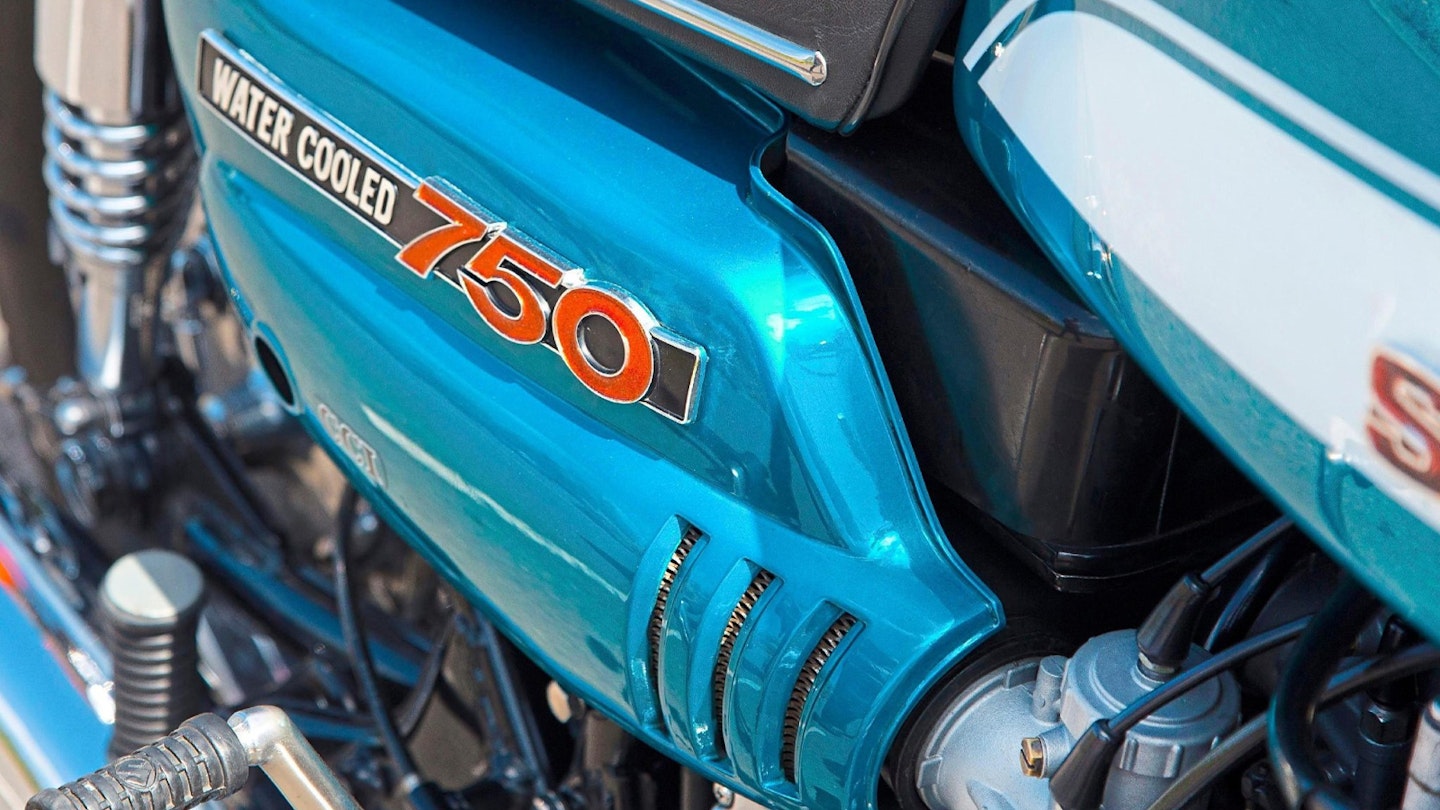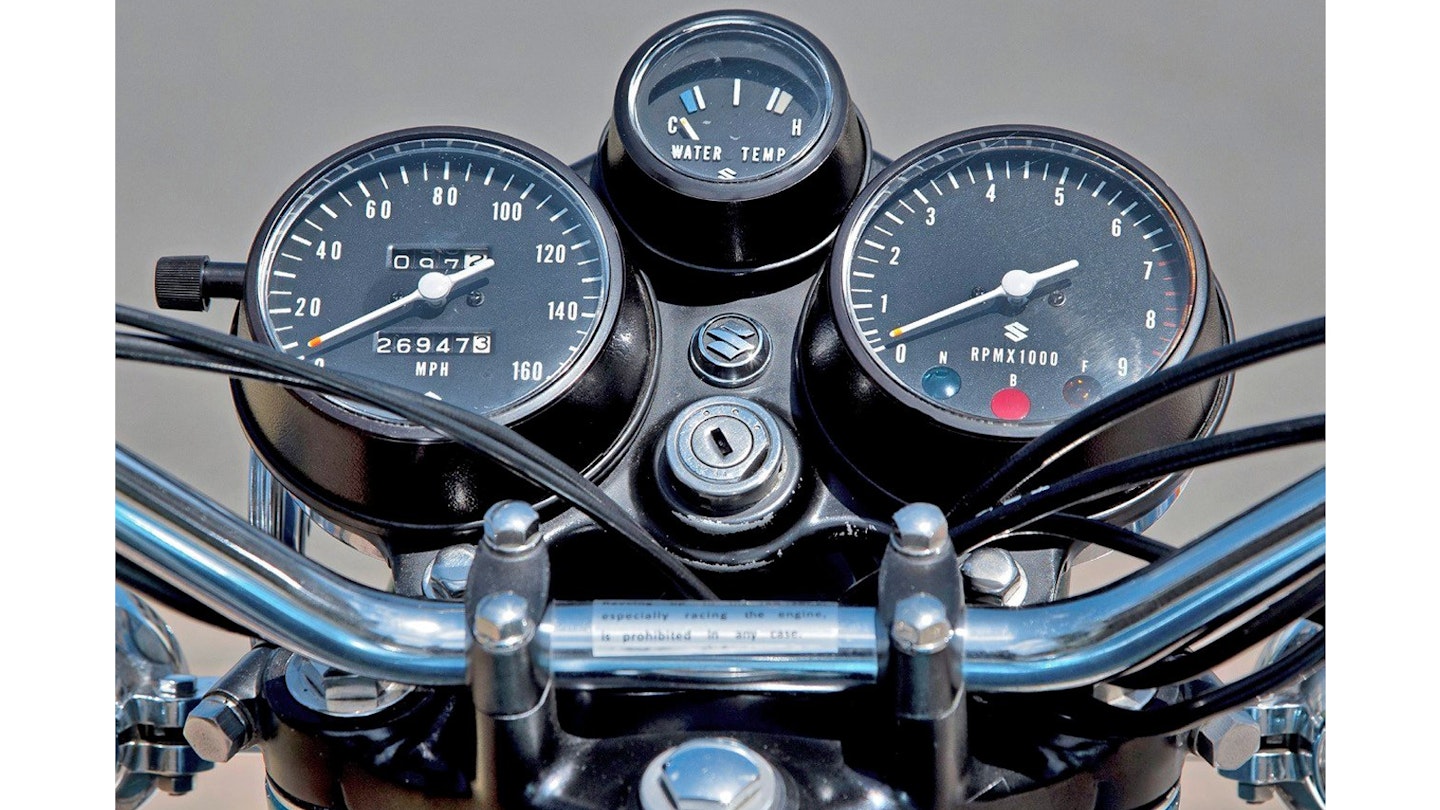RICK RIDES
Its nicknames aren’t that flattering, but will our air-cooled man think the ‘Water Buffalo’ and ‘Kettle’ monikers are undeserved?
WORDS RICK PARKINGTON PHOTOGRAPHY GARY MARGERUM

The starter button produces a burst of muted staccato, like a muzzled Uzi machine gun – and with a clunk that recalls putting a C90 cassette into its player, we’re in first gear and away. This isn’t the first time I’ve ridden a GT750 Suzuki – but it’s the one that I ended up enjoying the most. On a nostalgic level, I was given a die-cast model of a GT750 (complete with spring forks and back end) on my tenth birthday, so you could easily imagine that by riding Lloyd Benton’s lustrous Candy Jackal Blue J model on a rare sunny day in early summer, I’m living a childhood dream. Just imagine my little rosy cheeks and shining eyes as I pictured myself, one day, riding a real one...

Sorry, that’s some other kid. I never really engaged with that toy Suzuki. I wasn’t into the flashy modern look even then – and worse still, it just felt too chunky to be wheelied convincingly across the carpet. No, there’s no rose tint here, I’m just enjoying an old bike on modern roads – and much more than I expected. I’m sinking alarmingly comfortably into the ’70s vibe, even though I’m no lover of heavy bikes, safari suits or kipper ties. The GT750 is a far cry from the streaking strokers that made Suzuki famous in the ’60s; this is ‘the water buffalo’, remember – and with no disrespect to that noble beast, that’s hardly a compliment. So I find myself wondering just what Suzuki were up to in the 1970s.
Think about it. From the AP50 up, Suzuki seemed to place themselves between Honda’s responsible four-strokes and the rowdy Yamahas; even the triples were Beatles vs Stones alongside the Kawasakis – how could a company destined to bring us the RG500 make... a ‘water buffalo’? Well, having now been able to spend a bit of time with a GT750, I think I get it. You see, while a touring two-stroke triple may seem an odd idea today, that’s hindsight. We may view Japan’s defeat of the British industry like two armies meeting on a battlefield, but the Japanese companies were not allies – they were rivals as much as Triumph or Norton. When Honda stole the superbike show, Suzuki needed to fight back and their two-stroke background demanded a different approach.
‘Forget about the Kawasaki triples; if you view a GT750 as atwostroke CB750, it makes much more sense’

Forget about Kawasaki triples; if you view a GT750 as a two-stroke CB750, it makes much more sense.
And it’s a good effort too. Water cooling aided reliability and got rid of the rinky-dink rattles that plague alloy-finned two-strokes. Don’t expect arm-wrenching thrills, but the power delivery is strong and smooth – provided you keep above 2500rpm, there’s not much below. But alongside that, the Suzuki is really comfortable thanks to well-placed footrests, a generously proportioned saddle and wide handlebars. Now all of this I could probably have guessed, but what surprised me most of all was that the GT750 isn’t anything like as ungainly to ride as I expected. I felt very confident swinging it through bends – in fact, when I saw some sports bike riders approaching as I negotiated a roundabout, I couldn’t resist cranking it over to make as good a showing as possible. It did well enough to hold them off, too – water buffalo indeed!
The cornering made up for it all. I wasn’t hanging off the seat, of course – that’s not the deal when someone is kind enough to lend you their bike, but I was impressed with how secure the Suzuki felt and I suspect the Bridgestone Battlax tyres have much to do with it. In the ’70s, the one area British bikes still held a winning card was handling; Japanese frames, rear shocks and especially tyres left so much to be desired that many owners changed to Avon or Dunlop at the first service. That elevated the more notorious bikes from downright dangerous to adequate, but it seems the rubber of the last few years has turned those ‘widowmakers’ completely around. Whether that’s the technology – tyres now are generations ahead of those TT100s and Roadrunners which were designed for less fractious British bikes – or just the fact that the riders of these bikes are a bit more, ah, mature in their riding, I don’t know.
